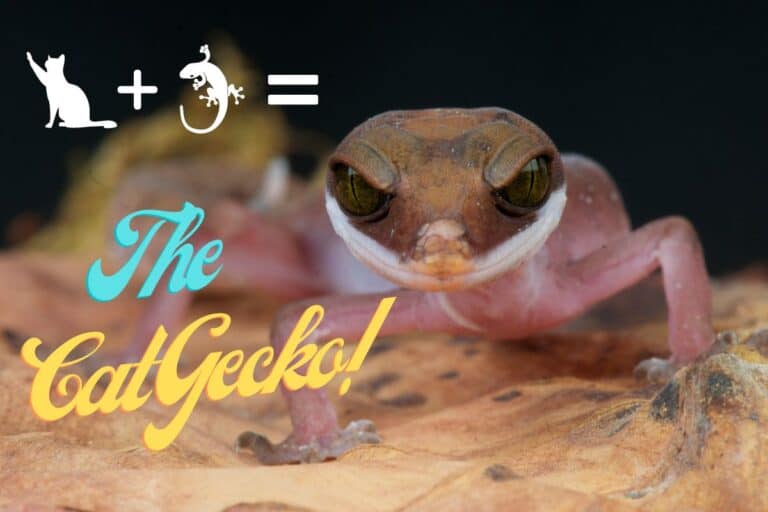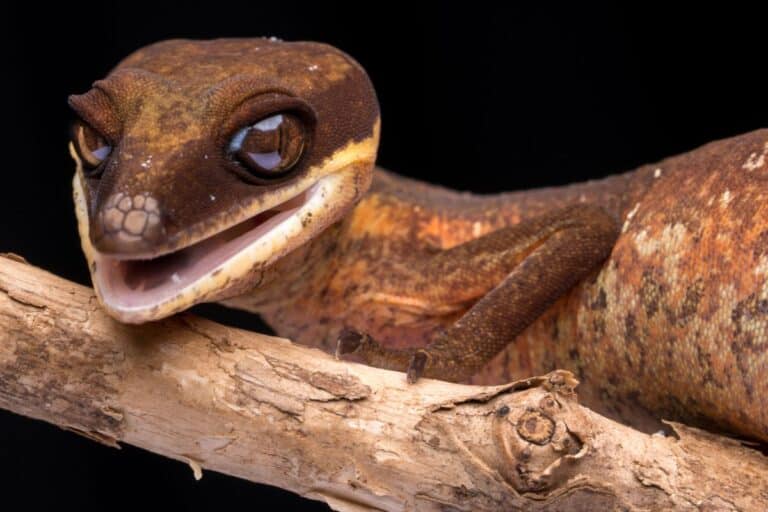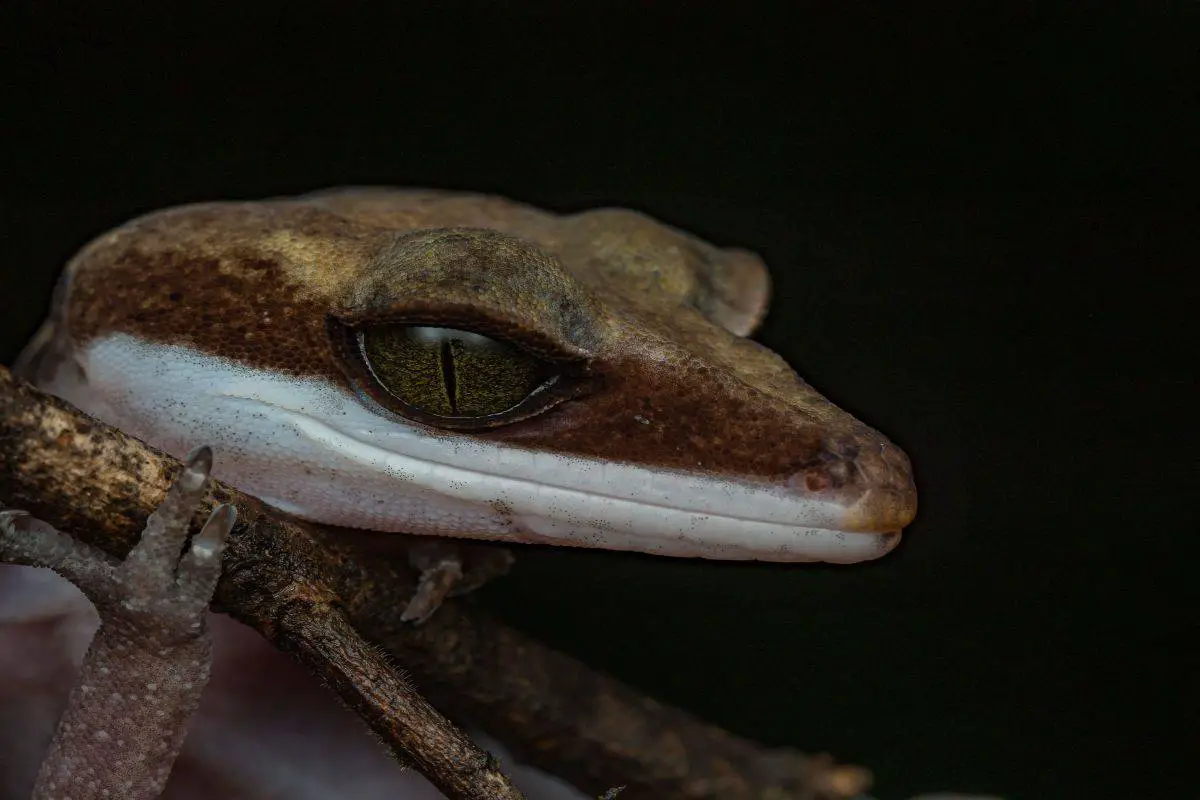Cat Gecko Care; a Comprehensive Guide
Cat geckos are nothing short of spectacular! It is fascinating to watch them methodically stalk their prey and pounce when the time is just right.
If that wasn’t enough, observing them with their tails curled around their body just like cats do, is simply adorable!
However, cat geckos are not your average gecko and as such have certain requirements and demands that novice reptile keepers may struggle with.
This care guide attempts to inform you about their husbandry requirements and gives you some tips and advice on keeping these unique geckos!
Reptile Roommate is a participant in the Amazon Services LLC Associates Program. As an Amazon Associate I earn from qualifying purchases.
The Malaysian Cat Gecko; aeluroscalabotes felinus
Cat geckos are found in Indonesia, Malaysia, Cambodia, Singapore and Thailand. Cat geckos curl their tails around their bodies when sleeping similar to cats!
Cat geckos also exhibit some cat-like behaviors; their slender bodies with thin legs and their pointed heads look quite cat-like and they tend to “stalk” prey in a controlled, deliberate manner much like cats.
Cat geckos are primarily nocturnal (active during nighttime hours) and semi arboreal; spending most of their time among branches of trees, shrubs and bushes in a humid rainforest environment.
Cat geckos can show some regional differences depending on their locales, namely the ‘green eyed cat gecko (Aeluroscalabotes dorsalis) or Borneo cat gecko.

Are Cat Geckos Good Pets?
Cat geckos can be extraordinary pets however, they are not recommended for beginners or those that have little experience with gecko species.
The cat gecko’s shy, reclusive nature and its small size and fragility can be difficult for inexperienced reptile keepers.
The biggest hurdle to keeping a cat gecko however, is that the overwhelming majority are wild caught and even those individuals can be hard to find. Captive bred animals are much more rare and will command a much higher price.
Tip: | all wild caught reptiles have increased risk of internal parasites and need more specialized/experienced care
Cat Gecko Size, Features and Coloration
Female cat geckos can reach 7 inches in length, while males are usually smaller and average 4 to 5 inches.
Cat geckos are lightly built, slender geckos that have a reddish-brown to rust color coloration with white spots speckled along their back, shin and belly.
Being nocturnal, they have large eyes for their body size helping them to see in the dark.
They possess small retractable claws that aid in climbing and their most prominent feature, their prehensile tail, assists in climbing and is often curled around them while sleeping just like a snoozing kitty!
Cat Gecko Care
Cat geckos are a small, timid species and many feel that they require a naturalistic or even bioactive enclosure to maximize success.
Malaysian Cat Gecko Handling
Cat geckos are somewhat delicate and quite shy (this goes doubly so for wild caught individuals) therefore handling this species should be kept to a minimum.

Cat Gecko Diet
Cat geckos are insectivores that will relish a variety of insects to hunt!
Appropriately sized crickets, isopods, roaches and snails can be given in the evenings, no more than 2 or 3 at a time, and any leftover or uneaten insects should be removed in the morning.
Adult cat geckos can be fed meals like this every 2-3 days.
Adding too many insects into your cat gecko’s enclosure can be stressful and they can be overwhelmed by all the activity.
These small bodied geckos are purported to have some mineral sensitivity, so supplementation should be approached with care. Once, every 2 weeks seems to be generally safe. (reptile vitamins and calcium)
Cat Gecko Setup and Enclosure
An enclosure measuring approximately 12” by 12” by 20” or larger can make a great home for a single cat gecko. Males can do well in a 12” x 12” x 20” and females (being larger) would work great in something like this from Zilla. (Zilla Vertical Starter Kit 16″ x 16″ x 22″)
Cat geckos are cryptic and like to feel safe so providing them with plenty of hiding spots is ideal. Because they are so small and thin, cat geckos utilize plants with large leaves and leaf litter spread onto the substrate as hides and for security.
Filling a cat gecko’s enclosure with a variety of plants, thin branches and vegetation will ensure that your cat gecko feels safe and comfortable in its habitat.
Plants such as ficus and pothos (scindapsus sp.) work very well in cat gecko enclosures! Cork Bark can also make a great climbing surface and provide an area that your cat gecko can use as a hide.
Heating
Cat geckos prefer cooler temperatures unlike many other popular reptiles. An ambient temperature between 72-78°F (22-25°C) works well during daytime hours.
A nighttime temperature drop to levels between 66-72°F (19-22°C) is appropriate.
Since the average household temperature falls within these ranges many keepers find that external heating, through heat lamps/mats, to be unnecessary.
Lighting
Cat geckos may be primarily nocturnal however, I am of the opinion that reptiles will always do better (and plants certainly so!) given a proper day/night light cycle which includes the addition of UVB.
A light cycle of approximately 10-12 hours a day will ensure proper plant growth and provide the natural day/night cycle that cat geckos would encounter in the wild.
Humidity
Humidity levels should be kept quite high in a cat gecko’s enclosure.
Humidity levels between 65-85% will help keep your cat gecko hydrated and ensure good health.
Humidity is a very important aspect of cat gecko care and should not be overlooked!
Daily misting with RO or distilled water is necessary to maintain humidity levels and to provide drinking water as these geckos will lap up droplets of water that form on the walls, leaves and decorations in the habitat.
Depending on your particular setup, frequent misting can lead to saturation of the substrate layer and an accumulation of water which is to be avoided!
You’ll need to observe your unique habitat and adjust your misting frequency accordingly.
Substrate
A substrate or either coco fiber or an equal-part-mixture of sand and peat moss works great to hold onto moisture and help make spot cleaning a breeze!
Just remember that any potted plants used in the enclosure should be kept in their pots with the top of the pots covered with rocks or moss to prevent your gecko from accessing the potting soil.
Care must be taken to ensure that with all the misting, moisture and high humidity levels the substrate doesn’t become oversaturated and increase the risk of mold, mildew and bacteria.
If your cat gecko habitat is bioactive, a cleanup crew consisting of isopods and springtails will do a wonderful job of consuming waste and organic materials.
Cat Geckos for Sale
Malaysian cat geckos are sometimes available at reptile shows and can also be purchased from a variety of online reptile sellers.
Cat geckos may not always be in stock so you may have to submit your name to a waiting list in order to be notified when they become available.
The vast majority of cat geckos that you’ll find are wild caught animals, so be prepared for the additional care and requirements tha come along with wild caught reptiles.
You can expect to pay anywhere between $100 and $199 for a single adult specimen.
Can Cat Geckos Live Together?
I am of the opinion that cat geckos do best when kept as single specimens.
A male/female pair can work as well as a pair of females, but like with most geckos avoid housing more than one male in the same enclosure.
Malaysian Cat Gecko Care Conclusion
Cat geckos are definitely not your ordinary geckos! A cat gecko’s unusual appearance and behavior is sure to win over reptile keepers everywhere.
Though they can prove a bit more difficult than some other popular geckos, cat geckos may just become the “next big thing” in gecko keeping!
“Cat gecko. (Aeluroscalabotes felinus.) Sarawak, Borneo.” by Jeremy Squire is licensed under CC BY-NA-SA 2.0


